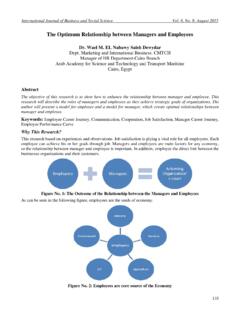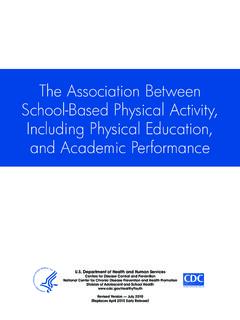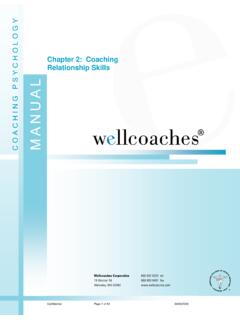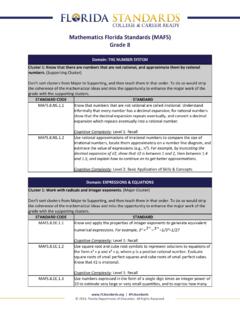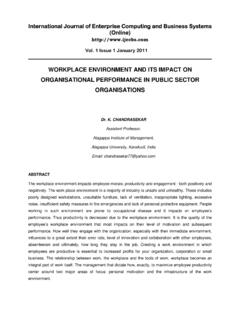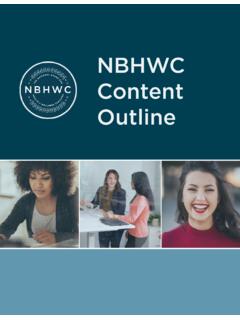Transcription of The Role of Teachers in Motivating Students To Learn ...
1 46 BU Journal of Graduate Studies in Education, Volume 9, Issue 1, 2017 The Role of Teachers in Motivating Students To Learn Davion Johnson Abstract Many factors motivate Students to Learn . These factors may be intrinsic or extrinsic. This article discusses the role of the teacher in Students motivation to Learn . The literature on learning and motivation reveals the ways that Teachers can increase Students motivation to Learn . While Students may have an innate desire to Learn , the external support provided by the teacher has a significant impact on Students learning.
2 The teacher s role in motivation includes, but is not limited to, creating an environment conducive to learning. The teacher s role in encouraging support of Students autonomy, relevance, and relatedness of the material increases motivation to Learn . Additionally, the teacher s ability to develop Students competence, interest in subject taught, and perception of self-efficacy are all important factors that influence Students motivation to Learn . This article, however, does not attempt to answer the extent to which these factors increase Students motivation to Learn . Motivation increases Students learning (Theobald, 2006).
3 Students learning can increase because of their own innate desires to perform or accomplish a task; however, Students learning may be affected by external factors such as rewards or incentives (Bain, 2004; Theobald, 2006). Students learning is not entirely dependent on their own motivation. Teachers play a vital role in increasing Students learning through motivational support (Schuitema, Peetsma, & Oort, 2016; Theobald, 2006; Thoonen, Sleegers, Peetsma, & Oort, 2011). Teachers can increase Students motivation to Learn by support of Students autonomy, relevance, relatedness, competence, Teachers interests in the subject, and self-efficacy (Ferlazzo, 2015; Schiefele & Schaffner, 2015; Schuitema et al.)
4 , 2016; Zhang, Solmon, & Gu, 2012). Though motivation can be intrinsic or extrinsic, it is important for teacher to create an environment that motivates Students learning. Motivation is perceived to have several meanings. Motivation is conceptualised as an innate desire that drives individuals to participate in an activity because of the satisfaction derived from it (Theobald, 2006). Another view of motivation suggests it is goal-directed learning, which stimulates and guides individuals toward a particular direction (Alexenoamen, 2009). As Students are motivated to Learn , they are more likely to achieve the goals set for them, either by themselves or by the teacher (Theobald, 2006).
5 Motivation, while it may have several definitions, influences Students learning. Students motivation to Learn is derived from various sources, either intrinsic or extrinsic (Theobald, 2006; Zhang, 2014). On one hand, Students are motivated to Learn naturally because of their own interest and enjoyment in the subject or task, which gives deep meaning to what they learned and the effects on their lives (Bain, 2004; Zhang, 2014). On the other hand, some Students Learn best because of a tangible reward or the value that is attached to the outcome of learning (Biggs, 1999; Bain, 2004; Zhang, 2014). Students who are intrinsically motivated tend to perform better on the given tasks and are keener to achieve success (Theobald, 2006; Biggs, 1999; Zhang, 2014).
6 Both intrinsic and extrinsic motivation increases Students drive to Learn . Teachers play a vital role in creating an environment that supports Students learning. They often do this through their support for Students autonomy (Schuitema et al., 2016). Teachers enable Students to identify with self, personal interests, and values by supporting their freedom of choice (Ferlazzo, 2015). By supporting Students choices and interests, Teachers help Students develop personal interest, involvement, and ownership of their work, which aid in motivation (Schuitema et al.; Stearns, 2013). Teachers also help Students to Learn by increasing their responsibility and participation in their own learning through letting them create their own goals and objectives (Theobald, 2006).
7 Research conducted on the nature of the relationship between Students perception of social support and autonomy support from their Teachers , and BU Journal of Graduate Studies in Education, Volume 9, Issue 1, 2017 47 self-regulated learning and achievement, showed a significant correlation between the Students perception of their Teachers autonomy support and self-regulated learning (Schuitema et al., 2016). Teachers who help their Students to become authors of their lives, take ownership and develop personal interest in their own work stimulate Students motivation, and increase their drive to Learn .
8 Connecting to the personal world of Students is another way that Teachers support their Students learning (Thoonen et al., 2011). Teachers connect learning to the personal world of their Students by making learning tasks more relevant through relating instructions to Students experiences (Ferlazzo, 2015; Thoonen et al., 2011). Students who understand the relevance for learning a particular concept, and what that learning implies for their everyday living, will generate interest (Theobald, 2006). A study explored the use of four classroom practices process-oriented instruction, differentiation, connecting to Students world (relevance), and cooperative learning in order to determine their relationship to Students motivation (Thoonen et al.)
9 , 2011). The findings revealed that connecting to the personal world (relevance) of Students had a positive outcome on Students motivation (Thoonen et al., 2011). Students need to see the links between what they do in class and how meaningful it is to their lives (Martin, Hodges-Kulinna, & Cothran, 2002). For example, Students could write reflections about the effect of course materials on their lives (Ferlazzo, 2015). Students are more likely motivated to Learn when what is learned has meaning and importance to their lives. Teachers who build positive relationships with their Students are more likely to influence their drive to Learn (Ferlazzo, 2015).
10 Building trust in a relationship takes time. Teachers should take time to know their Students and their interests (Theobald, 2006). To achieve this trust, Teachers should be open minded and occasionally share their own stories of success, struggles, failures, and achievement (Bain, 2004). Satisfaction of individuals basic need for relationship promotes intrinsic behaviour that can lead to Students motivation to Learn (Schuitema et al., 2016). Building relationship with Students can be difficult; however, being positive and encouraging can contribute to Students intrinsic motivation (Ferlazzo, 2015; Theobald, 2006). Research conducted into the relationship between Students perception of social support and autonomy support from their Teachers , and self-regulated learning and achievement, concluded that the Students learning, performance in school, and social and emotional well-being were all affected by the relationship with their Teachers (Schuitema et al.)










